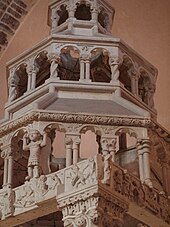Saint Triphon Cathedral
The Kotor Cathedral is the largest preserved Romanesque church of the eastern Adriatic coast and the most significant sacred building on the on the 1979 UNESCO list of World Heritage old town located Kotor in Montenegro . It is the cathedral of the diocese of Kotor .
history
The original construction of the cathedral dates from 809, when the Kotoran Andrija (Andreaccio) Saracenis (who finances the construction) bought the relics of St. Tryphon from the Venetians and brought them from Constantinople to Kotor.
The building is mentioned by the Basileus Constantine VII Porphyrogenetos in the De Administrando Imperio . At first it was assumed that it was round, until archaeological excavations in 1987 discovered angular foundations.
The construction of today's cathedral began in the time of the Kotor bishop Urscija in 1124. The cathedral was inaugurated on June 19, 1166 by the then Bishop Majo in a solemn ceremony in the presence of the Byzantine administrator of Duclea and Dalmatia Isak.
architecture
The cathedral is an outstanding work of Romanesque with elements of Byzantine architecture .
The original building changed due to the earthquakes of 1537, 1563, 1667 and 1979, especially externally, but the basic characteristics of the basilica floor plan with two entrance towers have not changed. A former crossing dome has now disappeared. In particular, Renaissance and Baroque elements are present in the building sculpture due to the renovation work.
The cathedral's original towers were destroyed in the 1667 earthquake. The 33 and 35 m high towers include the main portal, rose window and terrace.
The three-aisled basilica with three apses is 35.21 meters long and 17.47 meters wide. The main nave is supported by monolithic columns.
The original painting of the church consisted of Byzantine frescoes from 1331. The church, decorated by local fresco painters, was also used in the painting of the mausoleum of King Stefan Uroš III. Dečanski , the catholicon of the Visoki Dečani monastery , as the stylistic similarities and the importance of Kotoran artists at the court of the Nemanjids at the time testify.
The dome over the crossing was not rebuilt after the two catastrophic quakes in the 16th century.
Works of art
The cathedral houses one of the most valuable art collections on the eastern Adriatic coast and has one of the richest treasuries from the Middle Ages. In addition to remains of Byzantine frescoes, icons of the Maniera Greca as well as Byzantine icons and Gothic panel paintings are important works of art.
Among the sculptural works of art, the large silver altar dominates with the ciborium and the scenes of the life of St. Tryphon. In the High Middle Ages, gold and silversmiths were the specialty of the Kotoran blacksmiths' workshops, the most important of which are kept in the cathedral.
Web links
- Information on GCatholic.org (English)
Coordinates: 42 ° 25 ′ 26.8 ″ N , 18 ° 46 ′ 17.5 ″ E










